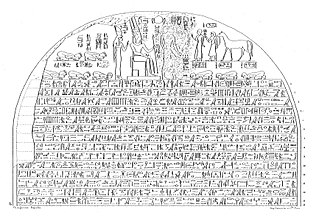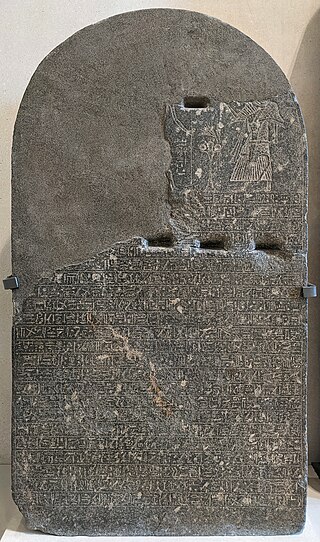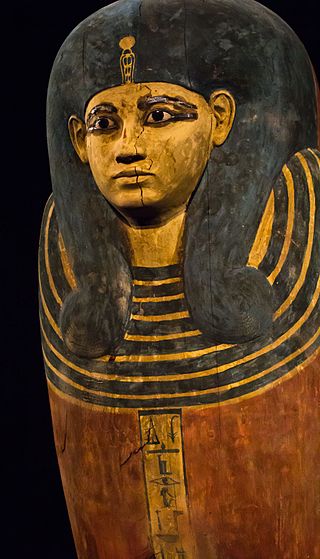Related Research Articles

Piye was an ancient Kushite king and founder of the Twenty-fifth Dynasty of Egypt, who ruled Egypt from 744–714 BC. He ruled from the city of Napata, located deep in Nubia, modern-day Sudan.

Menkheperre, son of Pinedjem I by wife Duathathor-Henuttawy, was the High Priest of Amun at Thebes in ancient Egypt from 1045 BC to 992 BC and de facto ruler of the south of the country.

Psusennes I was the third pharaoh of the 21st Dynasty who ruled from Tanis between 1047 and 1001 BC. Psusennes is the Greek version of his original name Pasibkhanu or Pasebakhaenniut, which means "The Star Appearing in the City" while his throne name, Akheperre Setepenamun, translates as "Great are the Manifestations of Ra, chosen of Amun." He was the son of Pinedjem I and Henuttawy, Ramesses XI's daughter by Tentamun. He married his sister Mutnedjmet.

Usermaatre Amenemope was an ancient Egyptian pharaoh of the 21st Dynasty who ruled between 1001–992 BC or 993–984 BC.

Masaharta or Masaherta was the High Priest of Amun at Thebes between 1054 and 1045 BC.

Pinedjem II was a High Priest of Amun at Thebes in Ancient Egypt from 990 BC to 969 BC and was the de facto ruler of the south of the country. He was married to his full sister Isetemkheb D and also to his niece Nesikhons, the daughter of his brother Smendes II. He succeeded Smendes II, who had a short rule.
Djedkhonsuefankh was a High Priest of Amun in Thebes believed to have been in office from 1046–1045 BC.

The Theban Tomb TT31 is located in Sheikh Abd el-Qurna, part of the Theban Necropolis, on the west bank of the Nile, opposite to Luxor. It is the burial place of the ancient Egyptian official, Khonsu, who was First Prophet of Menkheperre, during the 19th Dynasty or 20th Dynasty.

Duathathor-Henuttawy, Henuttawy or Henttawy("Adorer of Hathor; Mistress of the Two Lands") was an ancient Egyptian princess and later queen.
Henuttawy is the name of several royal ladies from Ancient Egypt.
Henuttawy B(“Lady of the Two Lands”) was an ancient Egyptian princess of the 21st Dynasty. Her father was Pinedjem I, High Priest of Amun and de facto ruler of Southern Egypt, her mother was Duathathor-Henuttawy, a daughter of Ramesses XI. She is depicted in the Luxor temple with her father and two sisters, Maatkare and Mutnedjmet. She was a Singer of Amun and Flautist of Mut.
Nesitanebetashru(ns-t3-nb.t-ỉšrw) was the name of two ancient Egyptian women. The name means “belonging to the lady of the ashru”; the ashru or isheru was a crescent-shaped sacred lake around the temples of solar goddesses, here it refers to Mut.
Nauny or Nany was an ancient Egyptian princess during the Twenty-first Dynasty, probably a daughter of High Priest, later Pharaoh Pinedjem I. The name of her mother, Tentnabekhenu is known only from Nauny's funerary papyrus.

Isetemkheb D was the sister-wife of the Theban High Priest of Amun Pinedjem II during the Twenty-first Dynasty of Egypt.

The Theban Tomb TT19 is located in Dra' Abu el-Naga', part of the Theban Necropolis, on the west bank of the Nile, opposite to Luxor. It is the burial place of the ancient Egyptian Amenmose, who was the high priest of Amenhotep of the Forecourt during the early Nineteenth Dynasty.

Henuttawy or Henettawy, was an ancient Egyptian princess and priestess during the 21st Dynasty.

The Banishment Stela or Maunier Stela is an ancient Egyptian stela issued in c.1050 BCE. It contains an amnesty decree of the 21st Dynasty Theban High Priests of Amun Menkheperre.

The Theban Tomb known as MMA 56 is located in Deir el-Bahari. It forms part of the Theban Necropolis, situated on the west bank of the Nile opposite Luxor. The tomb is the burial place of the ancient Egyptian Lady Ankhshepenwepet, also called Neb(et)-imauemhat, who dates to the 25th Dynasty. Ankhshepenwepet was a Singer in the Residence of Amun and an attendant of Shepenwepet I. It was excavated by Herbert E. Winlock on behalf of the Metropolitan Museum of Arts in 1923–24.

The Theban Tomb known as MMA 59 is located in Deir el-Bahari. It forms part of the Theban Necropolis, situated on the west bank of the Nile opposite Luxor. The tomb is the burial place of the Ancient Egyptian Henuttawy, who dates to the 21st Dynasty and was a Singer of Amun.

The Theban Tomb TT358 is located in Deir el-Bahari, part of the Theban Necropolis, on the west bank of the Nile, opposite to Luxor. The tomb belongs to the king's wife Ahmose-Meritamun, the sister and the wife of Pharaoh Amenhotep I. The tomb was later used for the additional burial of the King's daughter Nany, who was a daughter of Pharaoh Pinedjem I.
References
- ↑ H. E. Winlock, The Metropolitan Museum of Art Bulletin, New Series, Vol. 19, No. 12, "The Metropolitan Museum of Art: The Egyptian Expedition 1923–1924", (December 1924), pp. 31
- ↑ Tombs of Dynasty 21, Thebes, Online at the Metropolitan Museum website.
- 1 2 3 4 5 6 7 H. E. Winlock, The Metropolitan Museum of Art Bulletin, New Series, Vol. 19, No. 12, "The Metropolitan Museum of Art: The Egyptian Expedition 1923–1924", (December 1924), pp. 24–28
- ↑ Kenneth Kitchen, The Third Intermediate Period in Egypt (1100–650 BC). 3rd ed. (1996). p 67, Warminster: Aris & Phillips
- ↑ Kenneth Kitchen, The Third Intermediate Period in Egypt (1100–650 BC). 3rd ed. (1996). p. 534, Warminster: Aris & Phillips
- 1 2 3 Kathlyn M. Cooney, "Changing Burial Practices at the End of the New Kingdom: Defensive Adaptations in Tomb Commissions, Coffin Commissions, Coffin Decoration, and Mummification", Journal of the American Research Center in Egypt, p. 17
- ↑ Kenneth Kitchen, pp 67, 534